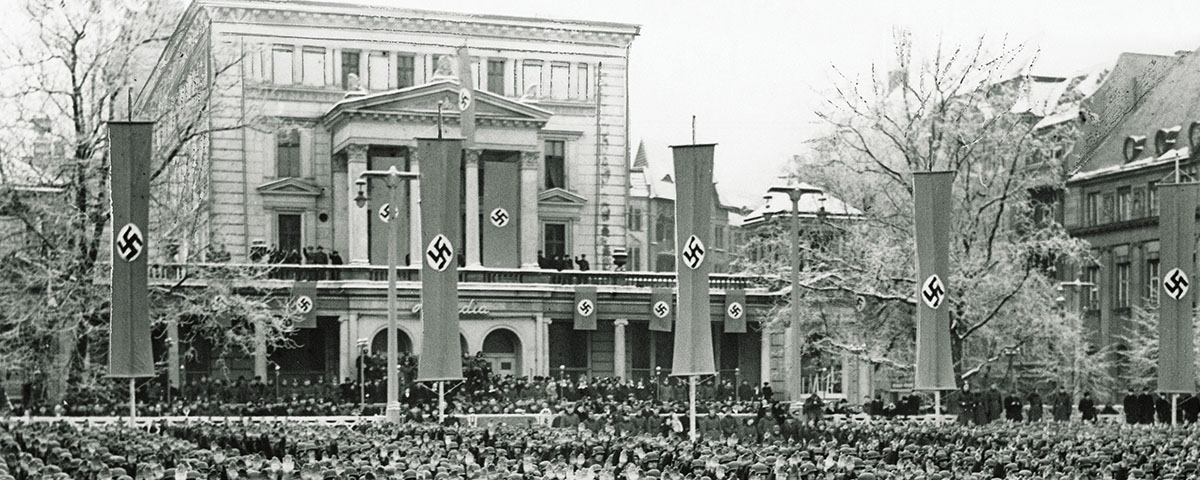Poznan was not the only Nazi-occupied city to hold out behind Soviet lines in the closing days of World War II, but it was arguably the most important, its fall paving the way for the final Russian drive into the very heart of Germany. The 1939 German invasion of Poland didn’t mark the first time the city had been under Teutonic rule. Prussia took Poznan in 1793, expanded the city and ringed it with a network of fortifications. The centerpiece was Fort Winiary, a massive redbrick and concrete garrison on high ground north of town, which locals dubbed the Citadel. German unification in 1871 brought Poznan under Kaiser Wilhelm I’s thumb, until Poland regained its independence after World War I.
When the Germans returned in 1939, Nazi administrators moved to Germanize the city. First, they herded most of Poznan’s intelligentsia into Fort VII, an old Prussian installation near the airport, where torture and murder were the rule. Then, to make room for German settlers, they deported thousands of ordinary Poles and exterminated the Jewish population. The Imperial Castle, once the Kaiser’s residence, became the Nazi administrative center.
The Germans didn’t stay long, though. On Jan. 12, 1945, the Soviets launched the Vistula-Oder Offensive, a major push across western Poland. A key rail and road junction en route to Berlin, Poznan was a crucial Soviet objective—and the Nazis knew it. Declaring it a “fortress city,” Adolf Hitler ordered it to be held at all costs. As the Red Army approached, some 60,000 German troops took up positions around the city.
Soviet armored spearheads bypassed Poznan on January 24, but the following day General Vasily Chuikov and his Eighth Guards Army—100,000 hardened veterans of Stalingrad—arrived. As Chuikov encircled Poznan, Hitler replaced garrison commander Maj. Gen. Ernst Mattern with Maj. Gen. Ernst Gonell, a fervent Nazi who believed the Führer would break through and rescue him.
For two weeks the snowy streets of Poznan witnessed bitter street fighting. German troops fought stoutly, hindering the crucial flow of supplies westward and tying up six Soviet divisions and hundreds of Polish fighters. But Chuikov methodically reduced the defenses, and by February 12 he had the Germans confined to the Citadel.
Chuikov besieged the fortress on February 18, his troops attempting to scale its ramparts using assault ladders. For several days German crossfire kept the Red Army at bay, but the Soviets relentlessly hammered away with aircraft, tanks and flamethrowers. In the early morning hours of February 22 Soviet tanks finally penetrated the Citadel walls. A despairing Gonell shot himself, and command reverted to Mattern, who capitulated. The Germans were beaten, but Poznan lay largely in ruins, and tens of thousands of people lay dead.
Today Poznan is a vibrant business and educational center, but it retains traces of its wartime past. The Imperial Castle houses the Zamek Culture Center [ckzamek.pl]. Outside stands a monument to a trio of University of Poznan mathematicians whose work decrypting Germany’s Enigma cipher machine paved the way for Anglo-American codebreaking operations. Housed in an adjacent structure resembling an Enigma machine is the exhibition “The Enigma Codebreakers” [enigmacentrum.pl], highlighting that Polish contribution to the Allied victory.
The 1945 battle destroyed the bulk of the Citadel, and most of what remained was torn down in the 1960s to create Citadel Park, with gardens and groves of trees, walking paths and playgrounds. Fragments of bastions and redoubts remain. The Soviet-built Monument to the Heroes of the Poznan Citadel, a 75-foot obelisk, dominates the south end of the park, nearly 6,000 Soviet dead lying in an adjacent cemetery. Polish dead rest nearby, while a British cemetery holds fallen airmen and prisoners of war who died in captivity. Dotting the green space are several war memorials, including one honoring Chuikov.
The city’s Wielkopolska Independence Museum [wmn.poznan.pl] features five museums in one. Neither the Poznan Army Museum (honoring a local military unit) nor the Armaments Museum is devoted specifically to the 1945 battle, but both are housed in restored period buildings. Also part of the network is the Wielkopolska Martyrs Museum, on the grounds of the Fort VII concentration camp, lest Poles forget.





